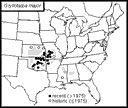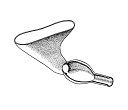|
Song at 25°C:
|
A loud beep, beep, beep reminiscent of some fire alarms; regular, brief chirps issuing from a well-formed acoustical burrow; ca. 2-3 ch/s, 13-35 p/ch, 2.0 kHz, 120 p/s. Calling begins near sunset and lasts for about 1 hour. The distinctive song of the prairie mole cricket, which can be heard as far away as 400 m, has greatly facilitated the mapping of its current distribution. The song of Neocurtilla hexadactyla is much less intense, and although its chirp rhythm is similar, its chirps have half the pulses at half the pulse rate.
|
|
Identification:
|
Basal projection of fore femur blade-like; hind tibia with seven spines at apex, four on inner and three on outer side. Length 35-50 mm.
|
|
Similar species:
|
Neocurtilla hexadactyla is l9-33 mm and the basal projection of its forefemur is lobe-like.
|
|
Habitat:
|
Relicts of tall grass prairie.
|
|
Season:
|
Nothing is known of the life cycle except that adults occur as early as 4 April and as late as 17 June. Two adults collected 20 October are the only evidence that adults occur at other seasons. Comparisons with other large mole crickets suggest that the first winter is spent as a small to medium nymph and that further development requires a year or more.
|
|
Remarks:
|
This species was once much more widespread, but most of its former habitat has been converted to agriculture. Early records included prairie areas in Mississippi and Illinois. Until recent studies revealed its habitat and characteristic song, it was largely known from occasional specimens taken at light.
|
|
More information:
|
Family Gryllotalpidae, genus Gryllotalpa.
|
|
References:
|
Caire et al. 1993; Figg & Calvert 1987; Hill 1998,1999; Walker & Figg 1990.
|
|
Nomenclature:
|
OSF (Orthoptera Species File Online).
|














